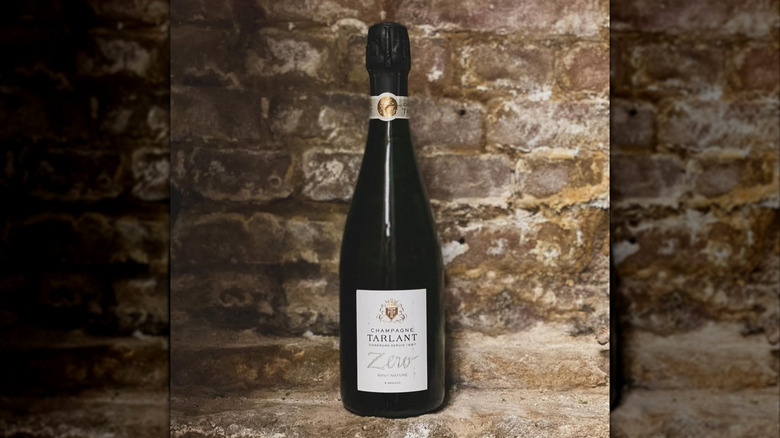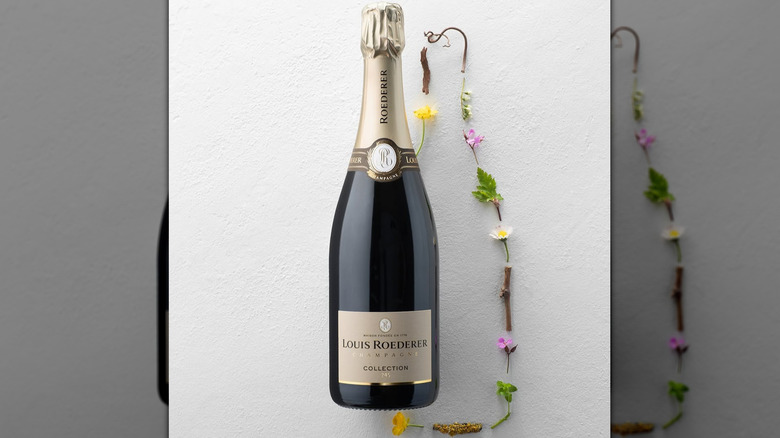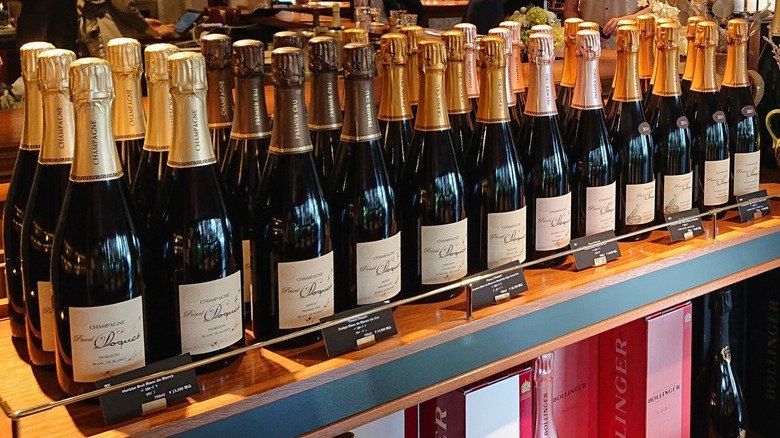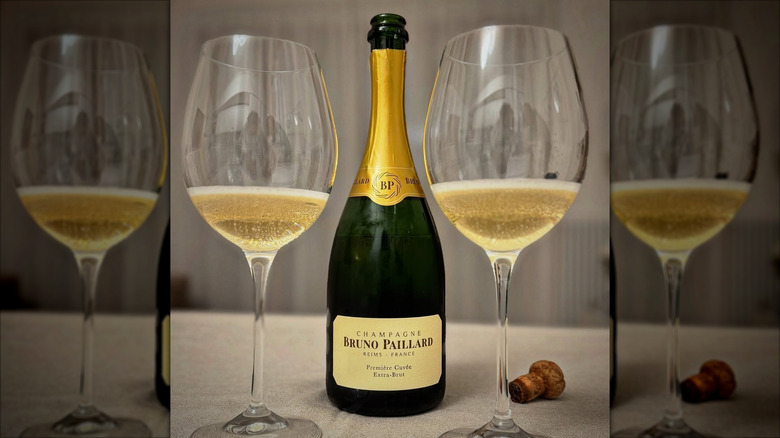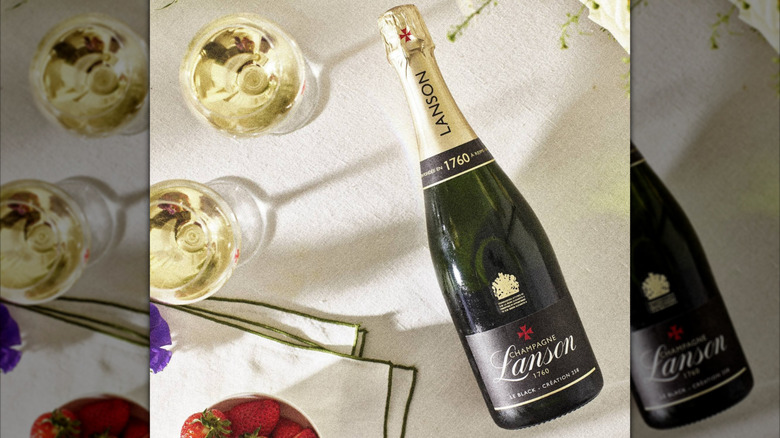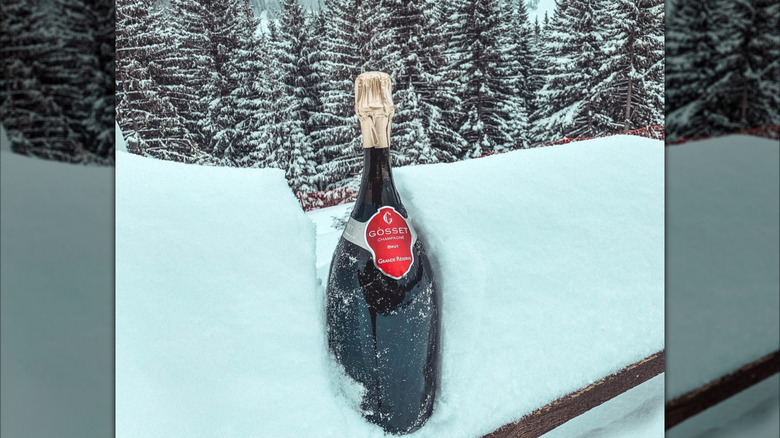15 Best Champagne Bottles To Celebrate The Holidays
It's hard to think of a drink that evokes more of a festive spirit than Champagne. The sparkling wine is a symbol of celebration and luxury, and for many people, it only comes around on special occasions. In particular, the holidays and New Year parties call for a bubbly drink to add to the cheer.
Although there are plenty of alternatives to Champagne (often more affordable), there's nothing quite like the allure of the French wine. It oozes elegance and tradition, and given the rigid production standards, you can usually guarantee getting something that tastes great. That said, between the large Champagne houses and the small growers, you're looking at over 16,000 producers.
To help you weed through the options, I've put together a selection of my favorite Champagne bottles to pick up for your holiday celebrations. As a certified specialist in wine, I've chosen these bottles for their exceptional qualities and taste. Several of the industry's key players are included, but I've purposefully left out some of the top-selling brands because you're bound to come across them prominently displayed wherever you shop anyway. Here are the Champagnes you should pop for your holiday festivities.
Pierre Gerbais Grains de Celles Extra Brut
Pierre Gerbais is a family-run Champagne house, with vines originally planted after World War II by Pierre's uncle Ulysse. Pierre joined the business and opened the winery, which he continues to run with his son, who has taken over as the winemaker. The vineyards are located in the southern part of the Champagne region and are farmed organically, with a minimal intervention approach in the cellar (no sulfites are added). Given its geographical proximity to Burgundy, the style of the wines draws some influences from the classic area.
Grains de Celles Extra Brut is one of several types of Champagnes the winery produces, and since 2018, a single vintage bottling. Made up of 50% pinot noir and 25% each of chardonnay and pinot blanc, this blend showcases the three varieties. It is made in an extra brut style with only 3 grams per liter of residual sugar (standard brut Champagne can have up to 12 grams per liter), yet the result is decidedly pleasant and palatable. This wine is creamy and medium-full-bodied, with notes of apple, pear, and lemon that infuse the optimal balance of sweetness and acidity.
Laherte Frères Blanc de Blancs Brut Nature
This family Champagne house was founded in the late 1800s and has continued to expand its vineyard territory since then. Several generations later, the current family members retain the original traditions, while engaging dynamically with the environment to express it at its best. A light touch in the cellar is preferred in order to highlight the qualities of the land and vines. Unlike many Champagne producers that ferment and mature their wines in stainless steel, Laherte Frères primarily uses oak, which adds a distinct character to the result.
For a bright and fresh Champagne from the winery's lineup, you can't go wrong with a bottle of Blanc de Blancs Brut Nature. This wine is made with grapes from old chardonnay vines in Épernay, the central part of Champagne, adding complexity to the taste. The Brut Nature label means no additional sugar is added to the final wine (dosage), giving it a crisp and vibrant palate. Notes of citrus, apple, and mango are present, along with honey blossom, ginger, and a mineral essence. The fine mousse adds richness to the mouthfeel making this Champagne a winner with or without food.
Tarlant Zero Brut Nature
The Tarlant family is among the original farmers in the Champagne region, with a presence dating back to the late 1600s. Eventually, the family started its own grower Champagne business in the early 1900s, in the hopes of showcasing the true value of the region beyond the large Champagne producers. Currently, the vineyards are farmed organically and biodynamically, and wines receive minimal intervention in the cellar.
Tarlant's Zero Brut Nature is an excellent example of the grower's style, featuring equal parts pinot meunier, pinot noir, and chardonnay grapes. The taste displays rich plum, apple, and citrus aromas with a mineral note and toasted brioche finish. The wine is aged on yeast cells for longer than the required standards, adding depth and fragrance. Although this Champagne is made with zero dosage, the taste is perfectly balanced and full. Dosage is often added to smoothen out acidity, but the Tarlant philosophy is to let time (both in the vineyard and cellar) bring equilibrium to the fruit and wine.
Louis Roederer Collection 245
Louis Roederer is no small player in the Champagne industry, as the producer of countless bottles, including Cristal. Yet, despite its size, the winery continues to be independent and family-run since the early 1800s. Harmony with nature and time are at the forefront of production, as the current generation understands the importance of patience when seeking to express the environment in a bottle. It's no surprise then that the winery farms sustainably to promote the conservation of its lands.
Louis Roederer Collection 245 is worthy of your holiday celebrations, having been created to celebrate the 245th blend since the winery's foundation. The wine is made with grapes from a few of the estate vineyards, with a blend of chardonnay, pinot noir, and pinot meunier. Boasting fresh fruit and concentrated aromas, this wine offers plenty of flavor and intensity in each sip, as evidenced by its velvety and luscious palate. A subtle salinity adds a juiciness to the character, while a smoky finish builds depth. It has plenty of structure to pair with food, and it will keep well if you pick up a few extra bottles for future celebrations.
Billecart-Salmon Le Réserve
Billecart-Salmon is especially known for its rosé Champagne, but the brand's Le Réserve bottle is a classic offering that will immediately enhance your holiday festivities. The Champagne house was founded over 200 years ago with the marriage of Nicolas François Billecart and Elisabeth Salmon, cementing the legacy of the family-run business. With vineyards that span the region, the wines are brimming with richness from the varied terroir.
Le Réserve is praised for its harmony and purity, featuring a blend of pinot noir, chardonnay, and pinot meunier grapes from top vineyards. Though complex in taste, it remains light and fresh on the palate, making this an excellent aperitif or wine to pair with food. Notes of white stone fruits, apple, pear, and flowers bring a fragrant character, while toasted biscuit aromas add depth and a fullness to this Champagne. The extra brut style keeps the wine crisp with a precise finish.
Bollinger Brut Special Cuvée
This Champagne house dates back to the late 1820s, when Athanasius Villermont, Jacques Bollinger, and Paul Renaudin founded it together. The Bollingers took over for the next century and a half, until the early 2000s, when Jérôme Philipon stepped in. The business continues to be managed with the family's philosophies and values, maintaining its renowned quality over the years. As one of few Champagne houses that grows all of its own grapes, the Bollinger brand can uphold its standards in the vineyard and cellar. Not to mention, it's James Bond's Champagne of choice!
The Brut Special Cuvée exudes the house style, "depth and subtlety," and features a blend of wines aged up to 15 years. The majority of the grapes (just under ⅔ pinot noir and the remainder chardonnay and pinot meunier) come from prestigious Grand and Premier Cru vineyards. Although Champagne regulations stipulate a minimum aging of 15 months in the cellar, Bollinger doubles the duration to give the wine more time to develop. With 7 to 8 grams per liter of residual sugar, it's smooth on the palate with notes of ripe fruit and hints of spice. Subtle nuttiness and toasted brioche add aromatic richness to this celebratory Champagne.
Ruinart 'R de Ruinart' Brut
As the first Champagne house founded in 1729, Ruinart has come a long way since its monk-guided beginnings, yet with an ever-present attention to its heritage. The deep underground white chalk cellars date back a couple of centuries and are designated as historic and UNESCO World Heritage sites. They're also the optimal location for the house's Champagnes to rest and mature until release. As for the vineyards, they've been skillfully farmed for centuries, expressing the terroir's fine qualities.
R de Ruinart Brut is the house style, featuring a blend of primarily chardonnay and pinot noir, along with pinot meunier grapes. The chardonnay comes from the prime chardonnay-growing vineyards, infusing the wine with its freshness and aromatic profile. Notes of apple, apricot, almonds, and hazelnuts add layers of flavor, while subtle hints of elderflower and a biscuity richness round it out with depth. Find the bottle wrapped in an elegant white "second skin" case, a sustainable packaging format the brand has implemented in the past few years.
Pascal Doquet Champs Libres Blanc de Blancs Extra Brut
Pascal Doquet became a leading Champagne producer after taking over his family winery and, soon after, created his own brand as a Grower Producer. Since 2001, organic farming practices have been employed in the vineyards, with a minimal approach in the cellar, allowing the fruit and yeast to work in harmony. Doquet is also the vice president of the Association of Organic Champagnes, emphasizing his quest to farm in tandem with the natural world. With annual numbers around 70,000 bottles (compared to about 19 million of Veuve Clicquot per year), you'll want to make a point to source this elegant Champagne.
Pascal Doquet Champs Libres Blanc de Blancs Extra Brut contains 100% chardonnay grapes, showing off their fragrant character in every sip. Notes of green apple, lemon, flowers, and brioche are complemented by the vibrant palate, making this a dynamic wine to sip. Meanwhile, the low dosage ensures every element of the fruit is displayed front and center. The crisp minerality enhances the freshness in the mouth and stands out alongside the creamy mousse and dry saline finish.
Pol Roger Brut Réserve
Pol Roger is a key name in the Champagne industry, and this family-run winery continues to uphold the philosophies of the relatives who founded it 175 years ago. While it has been referred to as "the gentleman's Champagne" (it was Winston Churchill's go-to pick), that's certainly not a restriction for anyone outside that category. Indeed, the Brut Réserve displays the Pol Roger house style and is well worth adding to your holiday celebrations — from start to finish.
This classic Champagne features equal parts pinot noir, chardonnay, and pinot meunier grapes from a wide range of vineyards, as well as wine blends from previous years, offering an excellent taste of the region. The different varieties infuse the Champagne with their unique qualities, bringing structure, freshness, and elegance to the glass. Notes of pear and mango are present, along with hints of white flowers, vanilla, and toasted brioche. Subtle honey and spice elements linger on the palate, adding complexity to this winning bottle.
Bruno Paillard Première Cuvée
Maison Bruno Paillard prioritizes purity with its Champagnes, expressing the true essence of this radiant wine in every bottle. Balance and complexity are key to the family-run winery's style, which is deeply personal and evocative of Bruno Paillard's taste and connection to the region. It starts in the vineyard with a sustainable approach and organic farming practices, letting the prized soils and terroir shine, as evidenced by the high-quality fruit.
The Première Cuvée Extra Brut Champagne is the signature house style, made with a blend of dozens of vineyard plots as well as reserve wines from previous years. Following every harvest, careful tasting and assessment are undertaken to maintain the wine's recognizable characteristics year after year. The blend is pinot noir dominant (some of it aged in oak barrels for additional depth), along with chardonnay and pinot meunier to complete. The wine matures longer than required to allow it to evolve in the bottle, resulting in an exceptional taste once popped. Expect notes of citrus, raspberry, red currant, and dried fruits, with a nutty toasted finish and crispness thanks to the low residual sugar.
Fleury Blanc de Noirs Brut
Biodynamic wine lovers will want to scoop up a bottle of Fleury Champagne, the first producer in the region to farm according to these holistic principles since the early '90s. Fleury is a family estate that grows and purchases fruit for its wines, with vineyards situated in the south of the appellation. A few generations in, the organic wines are now produced with minimal intervention in the cellar, including low dosage and sulfite additions. With a continuous focus on tradition and harmony with nature, Fleury is a stellar Champagne producer.
The majority of the vines are planted with pinot noir, making Fleury's Blanc de Noirs Brut an excellent choice to discover the brand. Developed in the mid-1950s, this wine consists of 100% pinot noir grapes, giving it a structured finesse that makes it an effortless sip. Fruity notes of peach, ripe apple, and black cherry are present along with hints of toasted brioche. The brut dosage style keeps the wine delicate on the palate and gives it a smooth finish.
Lanson Le Black Création Brut
Going strong since the mid-1700s, Lanson is one of the oldest Champagne houses around. Its heritage and know-how are evident in its wines, which stand as a fine example of the sparkling icon. Since 1900, Lanson has been awarded the Royal Warrant by Queen Victoria, a designation given to companies that supply items for the Royal Court. This recognition is just one more confirmation of the excellence you'll find in a Lanson bottle.
Le Black Création Brut is the house Champagne, and with good reason. The pinot noir dominant wine consists of a blend of the current and past vintages, aged both in stainless steel and oak barrels for additional complexity. It's crisp and vibrant, bringing with it an aromatic elegance that lingers on the palate. Notes of pear, citrus, and apple infuse freshness, while dried fruit and brioche aromas add depth. The number on the bottle label indicates how many harvests have taken place since the foundation of the brand, as a reminder of Lanson's overarching legacy.
Perrier-Jouët Grand Brut
Following the marriage of Pierre-Nicolas Perrier and Rose-Adélaide Jouët in the early 1800s, this classic Champagne house was born. With vineyards in the prime chardonnay-growing region, the two built the foundations of what would become an empire. Regenerative viticulture and sustainable practices are part of the present mission while seeking to display the richness of the terroir in the bottle. In the cellar, time and patience are respected in order for the wines to naturally develop their fullest potential.
The Grand Brut Champagne is a fantastic offering by Perrier-Jouët that showcases the signature house style. It has evolved from the Cuvée K created in the mid-1850s, which was unique at the time for its brut dosage level. Thanks to the perfectly ripened grapes, the subtle dosage gives this wine a rich mouthfeel without weighing it down. Made with the three main Champagne varieties (chardonnay, pinot noir, and pinot meunier), it has a well-balanced and vibrant character. On the palate, a fragrant aromatic profile displays notes of fresh fruit, vanilla, nuts, flowers, and toasted brioche.
Gosset Grande Réserve Brut
Gosset Champagne dates back to the 1500s when Pierre Gosset started a merchant business in the area. Originally producing still wines, the winery went on to add sparkling wines to its repertoire. Since then, its style has remained fresh and elegant, with a focus on retaining the fruit's natural qualities. Although Gosset Champagne is no longer owned by the Gosset family, it has been run by the Renaud-Cointreau group (a family-owned business) since the '90s. The company still prioritizes the expression of the Gosset style, ensuring the brand's legacy lives on.
Gosset Grande Réserve Brut is made of equal parts pinot noir and chardonnay, as well as a small amount of pinot meunier grapes. It is the house style and the best bottle to taste to understand this iconic producer. Fresh notes of lemon meringue and yellow plums are present at first, followed by richer honeyed and toasted aromas. A floral element brings fragrance to the character, while a hint of acidity keeps it crisp and bright. The result is an elegant Champagne you'll want to serve as an aperitif and keep pouring throughout your meal.
Taittinger Brut Réserve
Taittinger is a big name in Champagne, with wines that are reliably made with care and precision. The Taittinger family has been at the helm of the business for the past century (with a brief hiatus in the mid-aughts), ensuring its standards continue to be upheld. The house owns several vineyard sites across the top areas of the region, and also purchases some fruit from growers to complete its production. The plots it farms are recognized for their sustainability and high environmental value, ensuring the fruit meets rigorous quality control standards.
The Brut Réserve is the brand's classic bottling, made with chardonnay, pinot noir, and pinot meunier sourced from 35 different vineyards. This gives the blend added layers of complexity thanks to the varied terroir, yet it remains fresh and delicate. The fine mousse carries aromas of ripe peach, white flowers, and vanilla, which linger as the bubbles coat the palate. Notes of honey and brioche infuse additional depth and come together with the fruit in this well-balanced Champagne.



